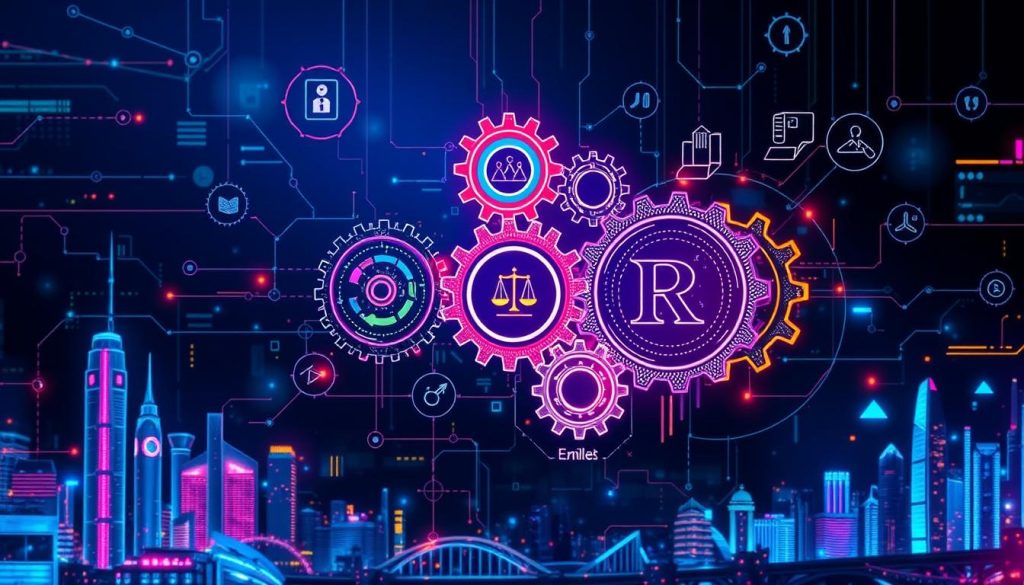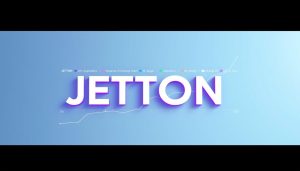Did you know the TON ecosystem saw a 12-times jump in daily transactions last year1? It leaped from 100,000 to 1.2 million activities. In less than six months, the total value within TON hit $350 million, up by 18 times1. This growth shows how key it is to understand TON’s regulations. Compliance is essential for telecoms and integrating TON’s blockchain tech.
TON’s progress places a spotlight on the need for regulation adherence2. From the $1.7 billion Telegram collected during its 2018 ICO to giving out 30 million TON tokens for community rewards worth $115 million, TON has grabbed lots of attention2. Grasping the regulatory landscape is critical. It allows stakeholders to craft solid compliance plans. This promotes lasting expansion in this fast-paced area.
Key Takeaways
- The TON ecosystem’s daily transaction volume increased 12-times in the past year1.
- Total value locked in TON has surged to $350 million1.
- Telegram’s ICO for TON raised an astounding $1.7 billion2.
- 30 million TON tokens allocated for community rewards in 20242.
- Importance of regulatory compliance in the continued growth of TON.
Understanding TON and Its Regulatory Landscape
The journey of TON, started by the Durov brothers, shows a bold path from its start to dealing with regulatory issues. This platform didn’t just gather a lot of money. It also faced close watch, which greatly shaped its growth.
The Genesis of TON
TON, short for Telegram Open Network, came into the tech world with big plans for a scalable blockchain network. In its ICO in 2018, TON raised over $1.7 billion. This showed investors really believed in it3. By using a setup with many chains, TON improved flexibility and how well different parts work together, even with a lot of nodes4.
Regulatory Scrutiny and Legal Battles
But TON’s quick growth and big funding caught the eye of regulators. The SEC stepped in fast, starting long legal fights. This put a lot of pressure on TON to match blockchain rules. Because of this, TON had to move from being company-led to being run by its community. This switch changed how it grew and its plans a lot4.
The Role of SEC in TON’s Development
The SEC was key in setting the rules for TON. This close watch made sure TON followed strict blockchain rules to protect investors. The fights with the SEC showed important compliance issues during TON’s early days. This made the developers focus more on following rules. Now, TON’s ways of operating have changed to meet these stricter rules. This makes sure it’s a safer place for its users3.
Key Regulatory Challenges Facing TON
TON, the blockchain platform, is up against many regulatory challenges. These obstacles stem from various national and global rules, and the need to follow U.S. securities law. It’s vital for TON to handle these issues well for both legal and operational victories.
Compliance with U.S. Securities Laws
Ensuring it meets U.S. securities law is one of TON’s main challenges. The SEC keeps a close eye on blockchain and crypto projects. It demands clearness and responsibility.
Section 6(a)(3)(c) of Executive Order 12866 outlines regulatory planning and review requirements, emphasizing the need for detailed analyses to ensure compliance5.
The Regulatory Right-to-Know Act asks for regulatory accounting statements. This makes TON’s legal road even harder as they need to report finances clearly5. The SEC wants TON to do a detailed benefit-cost analysis. This helps figure out the best options5. In essence, TON must look closely at benefits and costs, covering both measurable and immeasurable impacts5.
International Regulatory Pressures
Dealing with global regulations is crucial for TON too. The China ETS, for example, involves a huge portion of China’s CO2 emissions. This shows the level of regulatory expectations TON may encounter worldwide6. In 2023, many generation companies under the China ETS traded lots of allowances. This underlines the deep financial and operational efforts needed for compliance6.
The State Council’s new rules, starting 1 May 2024, aim to improve governance. They highlight key areas like duties of institutions and how allowances are givien out6. TON needs strong systems to address cross-border regulatory issues, keeping clear and responsible.
Below is a comparison table of U.S. versus international regulatory needs:
| Regulatory Aspect | U.S. Regulations | International Regulations |
|---|---|---|
| Scope | Encompasses securities law compliance, detailed regulatory analyses, and financial transparency. | Varies widely; e.g., China ETS covers emissions, mandatory disclosure of accurate emission information. |
| Key Requirements | Benefit-cost analysis, quantifying benefits and costs, demonstrating necessity of proposed actions. | Compliance with national standards, accurate emissions records, avoiding manipulation. |
| Implementation Challenges | Aligning with strict SEC scrutiny, providing transparent financial reports. | Addressing diverse regulatory frameworks, cross-border concerns, transparent governance. |
In the end, navigating securities law and international rules are big tasks for TON. Meeting with regulators and following worldwide concerns closely is pivotal for success.
The Importance of Regulatory Compliance in Telecommunications
The telecom regulations world is complex. It’s essential for companies in this sector to understand and follow these rules. This ensures operations run smoothly and keeps personal info safe. The National Telecommunications and Information Administration (NTIA) promotes a self-regulatory method. This approach uses industry knowledge and norms to protect personal info7.
Legal Implications for Non-Compliance
Ignoring telecom regulations can lead to big troubles. Companies can face huge fines, legal issues, and damage to their reputation. It’s crucial for these businesses to stick to the rules. Various methods like self-regulation, market practices, and government action help with privacy concerns in telecom7. The Federal Communications Commission (FCC) sets and enforces standards in this field, with help from the Common Carrier Bureau and Cable Services Bureau8.
Strategies for Ensuring Compliance
To stay compliant, telecom companies need strong strategies. These should include keeping up with regulatory updates and applying compliance guidelines strictly. Over 100 groups help set standards in this field. It’s important to stay informed about these changes8. Using self-regulation and meeting international standards helps in entering global markets8. Legal measures also protect privacy through clear government rules7.
Using these strategies helps companies follow the rules and builds customer trust. Knowing and applying the regulatory framework helps avoid legal issues. It also makes the telecom world safer and more trustworthy for everyone.
TON’s Journey Through Regulatory Hurdles
TON’s path through regulations faced both obstacles and changes. From the start, the platform dealt with close examination. This shaped its path to follow rules.
Initial Regulatory Reactions
The first reactions to TON showed how uncertain things were with blockchain laws. Agencies responded quickly to the growing crypto world. The Securities and Exchange Commission (SEC) was key early on. They stressed the need to follow securities laws. This was just the beginning of TON’s regulatory journey.
Subsequent Legal Developments
After the first challenges, things kept changing for TON. It adjusted to new rules, keeping up with changes from authorities. A big step for TON was meeting new standards after December 6, 20229.
TON also faced different compliance deadlines, up to five years in some places9. This made it tricky to meet both federal and state rules.
Dealing with regulations, TON set up ways to check on issues like “Super Emitter” programs9. This was key for finding and fixing compliance problems early.
In conclusion, TON’s story shows how rules change and how the platform works to keep up. This highlights the need to always be aware of new regulations and find ways to comply.
Best Practices for Navigating TON Regulatory Concerns
To handle TON regulations well, it’s key to stay alert to changes. Acting early to comply is also crucial. Bear these important strategies in mind to boost your approach.
Staying Updated with Regulatory Changes
Keeping up with new rules is essential for TON compliance. For example, compliance pros must know the duties and risks pointed out by the New York Bar Association, the SEC, and FINRA’s notice 221010. Also, since November 2023, freight brokers and carriers need an MC number to transport goods11. To stay informed, regularly check for updates from key regulatory bodies and fold this info into your compliance efforts.
Implementing Compliance Guidelines
Following compliance guides is key to setting up TON best practices. Updating Written Supervisory Procedures (WSPs) helps manage risks and makes supervisory roles clear10. Small firms should grasp their risk and clearly outline supervisory duties10. The ELD mandate, important for the trucking sector, calls for precise logging of work hours to prevent tiredness-related accidents11. By having distinct supervisory plans, regular training, and detailed compliance records, companies can meet these standards.
In short, adopting these TON strategies not only keeps you ahead in regulatory updates. It also strengthens your compliance structure. This ensures your operations follow the latest rules, reducing legal risks.
Impact of Regulatory Requirements on TON’s Development
Regulatory rules greatly influence TON’s growth path, providing both hurdles and chances. Rules demand TON create smart, multifaceted plans for compliance. This helps TON stay competitive and innovative.
Challenges and Opportunities
TON faces the big task of meeting different rules in various places. It spends a lot on legal help and following the rules, like those from the U.S. SEC12. Yet, these challenges bring chances. By following rules, TON gains trust and may attract big investments.
Following rules also lets TON find new paths it couldn’t before. Like, following EPR laws is not just a must-do but also gives TON a competitive edge. It shows TON supports going green and builds a good market name13. Balancing rule demands with sustainable growth makes TON a leader.
Strategic Adaptations
TON has crafted plans to keep up with and grow despite regulatory tests. One big plan is to always monitor rule changes. This way, TON quickly adjusts its operations to follow rules and avoid legal issues.
TON also makes following rules a key part of its growth plans. This makes following rules smoother and lessens the chance of breaking them. Having strong internal rules ensures TON’s work meets the highest standards.
TON’s efforts to face regulatory tests and grab chances show its strength and dedication to growth. These smart plans don’t just help TON meet rules but also push its long-term success and sustainability.
Legal Implications of TON Blockchain Applications
Knowing the legal implications of using TON blockchain is key. This technology, especially in telecoms and tech, has intricate laws. The rules vary from the U.S. to internationally, making the landscape diverse.
Following these rules is vital for companies. It helps them avoid legal issues. The SEC allowed 11 ETFs to follow bitcoin and ether, showing the need for strict rules14. By sticking to these, companies ensure financial stability and integrity.
The Tether and TON Foundation partnership also shows the demand for clear laws15. The TON network’s success with 650 dApps and significant growth potential underlines this. It shows how blockchain thrives within legal limits15.
International teamwork is crucial for regulating digital assets. Groups like the IMF and World Bank push for worldwide blockchain laws14. This not only lowers risks but also encourages innovation and growth.
Policy Considerations for TON Projects
Starting TON projects requires deep thought on rules and making strong internal policies. This ensures the project follows all rules and policies. It keeps the project in line with regulations.
Guidance from Regulatory Bodies
Regulatory bodies offer crucial advice for TON projects. For example, the Commission updated its Certificate Policy Statement to help certify new projects16. There are also policies like the Interim GHG Policy Statement that set emission limits16. Following these guidelines helps provide certainty for everyone involved16.
Environmental rules now mix market strategies and hybrid methods. This makes it easier and cheaper than old rules17. TON projects must keep up with these changes to stay compliant.
Developing Internal Policies
Creating strong internal policies is key for TON project compliance. These policies must look at economic and environmental impacts, including effects on landowners and communities focused on environmental justice16. They also need to cover GHG emissions from all project stages16. This helps in creating compliant project plans.
Using set regulations as a safety measure, TON projects can hit required pollution limits. This approach allows for environmental care and economic benefits17. Shifting abatement efforts based on their costs can save money and increase project compliance cost-effectiveness17.
| Policy Aspect | Considerations |
|---|---|
| Regulatory Guidance | Updated Certificate Policies, Market-Based Incentives, Hybrid Approaches1617 |
| Emission Thresholds | 100,000 metric tons/year for EIS16 |
| Internal Policy Development | Comprehensive GHG Emissions, Economic and Environmental Impact1617 |
| Prescriptive Regulations | Backstop Measures, Cost-Effectiveness, Pollution Control17 |
Developing a Robust TON Compliance Program
Building a strong TON compliance program requires knowing its key parts and how important regulatory training is. By emphasizing the main components and ongoing education, organizations develop a compliance culture. This ensures they follow the rules.
Key Elements of an Effective Compliance Program
A successful TON compliance program relies on key elements. It’s crucial to set a strong compliance leadership from the start. This makes sure rules, both local and global, are followed18. Prioritizing compliance gives companies in regulated fields, like drugs, a leg up and builds trust18.
Leaders must push for compliance and set up ways for staff to voice concerns18. Working with regulatory bodies is key for handling compliance well18. Plus, regular checks help fix issues early, strengthening the compliance setup18.
Training and Education
For a TON compliance program to last, ongoing training on rules is critical. Educating workers about compliance increases their awareness and commitment to standards18. A 2011 research found that compliance programs lower the urge to cut corners. They also protect those who report wrongdoing19. Such programs help in reporting wrong actions, making a workplace more honest and ethical19. Rewarding those who show a strong commitment to compliance can foster a culture of active compliance in the organization18.
By adding needed compliance elements and providing constant training, organizations can create a robust TON compliance program. This not only fulfills regulatory needs but also champions integrity and responsibility.
The Role of Stakeholders in TON Regulatory Compliance
In the TON ecosystem, staying compliant heavily relies on the hard work of many stakeholders. Developers and investors play key roles in keeping things according to the rules.
Responsibilities of Developers
Developers are key to making sure their creations follow all the legal needs of the TON world. They have to keep up with new rules and include strict compliance measures in their coding work. For example, they need to track laws like the Algorithmic Accountability Act that makes businesses ensure their AI is clear and fair20.
They also need to work on making their systems more transparent and understandable. This matches what many AI ethics guidelines ask for20.
Obligations of Investors
Investors have a big part in supporting legal compliance in the TON world, too. They make sure their investments match up with the required standards and rules. Facing worries about too many rules, lots of investors are upping their spending on staying compliant. In fact, 65% of organizations see their compliance budgets growing21.
By demanding strong compliance plans and promoting a culture that values legal compliance, investors lower risks. This helps the TON ecosystem grow in a stable, legal way.
The rules for stakeholders in the TON world keep changing. Developers and investors must fully understand and act on their duties to keep the ecosystem legal and intact. By staying proactive, they both help create a strong and law-abiding tech environment.
| Stakeholder | Responsibilities | Impact |
|---|---|---|
| Developers |
|
|
| Investors |
|
|
Future Prospects and Regulatory Forecast for TON
The TON ecosystem stands on the edge of big regulatory changes. These changes could completely change its future. Staying ahead and adapting is key for compliance and seizing new chances.
Anticipated Regulatory Changes
Governments around the world are tackling the fast-changing digital world. They predict tighter rules for TON from regulators like the SEC. These rules aim to make blockchain transactions safer and more transparent. Also, global rules are expected to get tougher to manage the risks of international transactions.
McVey Global Insights shows that policy affects 40 percent of mining firms’ decisions. Places like the USA and Canada are making their tech project rules smoother22. These changes will deeply affect TON, especially in project growth and following rules.
Strategies for Future Compliance
The future of TON relies on knowing these changes and having a strong plan for compliance. Here are ways to stay ready for new regulations:
- Staying Updated: Keep an eye on news from bodies like the SEC to adapt quickly to new rules. This helps change compliance plans in time.
- Building a Compliance Team: Create a team that focuses on making sure all transactions follow the latest rules.
- Leveraging Partnerships: Work together with compliant firms like Tencent Cloud for their resources and knowledge23.
- Investing in Technology: Use the latest tech for easier monitoring and reporting. This step lessens risks and makes work easier for your team.
By using these tips, you’re ready for the coming changes. Planning ahead not only avoids legal issues but also boosts your operations and trust in TON’s future.
TON Compliance Guidelines: A Comprehensive Overview
Understanding TON compliance guidelines is key for following rules and avoiding legal issues. A strong compliance plan greatly reduces risks and helps develop TON projects strongly. We will go through the main rules and how to apply them.
Core Principles of the Guidelines
The TON compliance guidelines are based on important principles. These principles are crucial for following the rules. They include:
- Transparency: Sharing relevant information openly with others to build trust and responsibility.
- Accountability: Making sure everyone involved knows their duties.
- Risk Management: Identifying and reducing risks early.
- Continuous Improvement: Always improving how we comply to keep up with new rules.
To use these principles well in your work, you need a planned approach. Taking these guidelines seriously lets you build a strategy that is both strong and flexible.
Steps to Implement the Guidelines
To apply the TON compliance guidelines well, follow these steps:
- Conduct a Compliance Assessment: Start by seeing where you stand with compliance, finding gaps and areas to get better.
- Develop Compliance Policies: Make detailed policies based on these principles that meet regulations and project needs.
- Train and Educate: Make sure your team knows about these guidelines through ongoing learning and training.
- Implement Monitoring Systems: Use tools to keep an eye on compliance and catch problems early.
- Review and Update: Keep checking and improving your compliance plans to stay current with laws and news.
By taking these steps to implement the guidelines, organizations can stick to the TON compliance guidelines. This helps maintain a thorough compliance strategy, ensuring the long-term win and health of TON projects.
Recent data shows the trucking industry heavily feels regulation effects, with trucks moving 10.23 billion tons of goods in 2020. This was 72.5% of all domestic freight24. Following guidelines like the TON ones can make regulatory processes smoother in many fields, supporting vital compliance principles and meeting standards.
Understanding the Regulatory Framework for TON
The rules for Telegram Open Network (TON) change a lot worldwide. Different places have their own rules for using blockchain technology. It’s important to know these differences to follow the laws everywhere.
Differences in Regulatory Standards Worldwide
In the US, there’s a complex system of rules with many agencies. For example, over 70 agencies, like the FCC and EPA, make thousands of new rules every year. These affect many areas, from telecoms to the environment25. The IMO’s rule on ship emissions shows how tough environmental rules can be for ships26. But in places like the EU, there’s a shared goal under the Paris Agreement to cut emissions by 205026.
Navigating Cross-Border Compliance
Following TON rules across countries requires knowing many different regulations. Since 2019, big ships must report fuel use because of the IMO-DCS26. Following major regulatory body guidelines helps TON follow global rules. For instance, the US Coast Guard’s laws on ships show how to stay accountable27. A good strategy ensures meeting these international rules. Documents shared through the Department of Transportation’s site can offer more details27.
Having a strong rule-following strategy helps TON projects stay compliant everywhere. A clear way to submit regulatory papers helps. Keeping up with new rules and attending public meetings is also key27.
To learn more about TON investments, check out expert advice. A detailed guide is available here.
TON projects can follow complex international rules well by understanding these standards. This ensures they keep up with laws and supports their long-term growth in blockchain.
Dealing with Compliance Issues in TON Blockchain
Tackling compliance issues resolution in TON’s blockchain is tough due to its decentralized setup. It’s key for firms to balance adopting blockchain with staying compliant. All businesses should remember this28. The decentralized nature makes enforcing rules and tracking bad activities hard28.
The anonymity of blockchain platforms allows criminals to launder money and evade taxes. This increases regulatory worries28. To combat these TON blockchain challenges, regulators are working on ways to keep an eye on risks. These include scams and market swings28. The fast pace of blockchain advancements adds to the legal uncertainty for firms28.
To meet these TON blockchain challenges, firms need strong compliance strategies. TON’s Zero-Knowledge Proofs let transactions be checked without sharing private details. This helps keep user info safe while meeting laws29. TON’s setup, with sharding and multiple workchains, helps spread out control. This makes it tough for one group to see everything users do29.
Features like Telegram’s encrypted messaging, onion routing, and ring signatures boost privacy and security. These are crucial for sorting out legal issues tied to TON’s compliance troubles. Methods like CoinJoin keep users anonymous, balancing regulatory needs with the value of privacy29.
Governments around the globe are trying to create rules for digital currencies, impacting TON. With Telegram’s 900 million users getting wallet services, there are big security concerns. It’s vital for businesses to handle these concerns to use blockchain well and stay compliant30.
| Compliance Challenges | TON Solutions |
|---|---|
| Centralized Control and Regulatory Enforcement | Decentralization with Sharding and Multiple Workchains |
| Money Laundering and Tax Evasion | Onion Routing and Ring Signatures |
| Legal Uncertainties | Zero-Knowledge Proofs and Confidential Transactions |
| Security Concerns with Wallet Integration | End-to-End Encryption through Telegram |
Key Insights on Ensuring TON’s Legal and Regulatory Success
Strategic planning and deep knowledge of compliance are key to TON’s legal success. Studying case studies and expert advice helps navigate complex regulations. Analyzing specific case studies and expert recommendations can offer valuable insights into navigating the complex regulatory landscape.
Case Studies of Successful Compliance
Understanding international and local regulations is crucial for compliance success. Challenges exist, but strategies can turn these into advantages. This is shown in many high-profile cases.
The company Huawei faced many standards issues but improved by focusing on compliance training and supply chain management. Their efforts not only met compliance needs but also boosted their market stance without big cost increases31.
In the drug industry, companies like Pfizer used tech to meet standards efficiently32. Apple put in place detailed compliance guides, focusing on audits, training, and reports. This improved their legal standing and cut down risks32.
Expert Recommendations
Experts say to weave compliance into your strategic plan. This means setting clear rules, staying current with laws, and regularly updating compliance activities.
- Stay Updated: Keep an eye on regulatory changes. Industry newsletters and forums can help stay informed about new laws.
- Invest in Training: Training employees regularly helps everyone know their part. It shows the legal weight of their actions.
- Implement Robust Policies: Having strong internal policies is important. Clear rules, audits, and open reporting keep compliance tight.
- Leverage Technology: Using technology simplifies compliance processes. It ensures precise record-keeping and reporting33.
Blending these expert tips into your strategy boosts your ability to handle regulatory issues. Showing you’re serious about compliance can also improve your reputation and attract investors who value legal adherence.
TON’s legal journey offers lessons for others. By adopting effective compliance tactics and listening to experts, companies can manage regulatory hurdles. Keeping up with legal insights and standards is a must for thriving in today’s regulatory scene.
Conclusion
Dealing with TON regulatory compliance is complex. It’s crucial to know and follow lots of regulations. The story of TON Services, Inc. and Qwest Corporation shows how important proper compliance is. It also shows the bad effects of not following the rules highlighted in this case34.
Since 1863, with the start of the Office of the Comptroller of the Currency, to the start of the Environmental Protection Agency in 1970, federal agencies have grown to meet new challenges. This growth shows why companies like TON need to stay updated on regulations. Especially in the telecommunications field34. These steps are crucial to make sure they follow the law35.
To comply with TON’s changing regulations, staying up to date, adapting quickly, and using compliance guidelines wisely are key. This way, your company won’t just meet current rules, but also adjust to new ones easily. By having strong compliance strategies for telecommunications, you stand a better chance at succeeding in this changing regulatory world.
FAQ
What are the key regulatory concerns associated with TON?
Can you provide a brief overview of TON’s inception and its ICO?
FAQ
What are the key regulatory concerns associated with TON?
The main issues for TON, or Telegram Open Network, involve following telecom laws, sticking to securities regulations, dealing with laws across countries, and handling a lot of attention from global bodies like the SEC.
Can you provide a brief overview of TON’s inception and its ICO?
TON was started by the Durov brothers, who also created Telegram. They raised
FAQ
What are the key regulatory concerns associated with TON?
The main issues for TON, or Telegram Open Network, involve following telecom laws, sticking to securities regulations, dealing with laws across countries, and handling a lot of attention from global bodies like the SEC.
Can you provide a brief overview of TON’s inception and its ICO?
TON was started by the Durov brothers, who also created Telegram. They raised $1.7 billion through an Initial Coin Offering (ICO). This ICO got a lot of attention, especially from the SEC, because of securities law concerns.
How did regulatory scrutiny impact TON’s development?
TON felt a big impact from the SEC’s close watch. Legal issues made TON change from a corporate project to one driven by its community. This changed its path and how it deals with rules.
What are the main challenges TON faces in complying with U.S. securities laws?
TON’s biggest challenge is to make sure its technology and tokens don’t break U.S. securities laws. The SEC’s actions against Telegram highlighted the need for strong compliance and legal strategies.
How do international regulatory pressures affect TON?
Dealing with rules from different places makes TON’s life harder. It has to juggle different legal standards, deal with rules from many places, and keep things consistent all over the world.
Why is regulatory compliance crucial in the telecommunications sector for TON?
For technologies like TON, following regulatory rules is key to avoid legal trouble and keep running smoothly. Meeting these rules reduces risks and builds trust with everyone involved.
What legal implications could arise from non-compliance with telecommunications regulations?
Ignoring telecom rules can lead to big troubles, like fines or restrictions. TON must work carefully to follow these rules to avoid such issues.
How did TON adapt after facing initial regulatory reactions and legal developments?
TON responded to early issues by becoming community-led and tweaking its compliance plans. These changes helped it continue developing and dealing with rules.
What are some best practices for staying updated with regulatory changes affecting TON?
It helps to watch for changes in the law, talk to experts, join forums, and communicate openly with authorities. Strong internal guidelines also keep an organization in front of regulatory updates.
How have regulatory requirements shaped TON’s development?
Rules have deeply affected TON, bringing both hurdles and chances for improvement. While following rules can be hard, it also leads to greater transparency and stronger operations.
What are the legal implications of deploying blockchain technology through TON applications?
Using blockchain in TON apps means navigating legal areas like data privacy, securities, and intellectual property rights. Understanding these legal landscapes is crucial to avoid risks.
What considerations are crucial for developing internal policies for TON projects?
Creating internal policies involves following regulatory advice, setting clear rules, training staff, and auditing regularly. These policies reduce risks and encourage a culture of following the rules.
What elements are essential in a robust TON compliance program?
A strong compliance program for TON needs a full plan, ongoing training, effective monitoring, clear reporting, and steady legal advice to tackle complex rules.
How can stakeholders like developers and investors contribute to TON’s regulatory compliance?
Developers and investors help by understanding their roles, following rules, staying informed about changes, and talking with legal experts to align operations with laws.
What strategies can TON employ to prepare for anticipated regulatory changes?
TON can get ready for new rules by assessing impacts, using flexible compliance plans, working closely with authorities, and educating stakeholders to stay ahead.
What steps are necessary to implement TON compliance guidelines effectively?
For effective guidelines, TON needs to pinpoint key principles, set clear protocols, ensure everyone follows, train thoroughly, and regularly check if guidelines are met.
How do differences in regulatory standards worldwide impact TON?
Global regulatory differences mean TON must tailor its approach in each place. It needs to know local laws, set varied strategies, and update practices to navigate these challenges.
What are common compliance issues in TON blockchain operations, and how can they be resolved?
TON often deals with data privacy, securities laws, and unauthorized transactions. Solutions include strong security, legal checks, reporting systems, and regulator interaction to meet standards.
Can you share case studies of successful compliance strategies in TON?
Successful strategies in TON show the importance of talking with regulators, having good compliance programs, teaching stakeholders, and adapting legal plans. These lead to success and less legal risk.
What expert recommendations exist for ensuring TON’s legal and regulatory success?
Experts suggest ongoing talks with authorities, investing in compliance training, clear reporting, routine audits, and promoting a culture that values legal compliance and risk management.
.7 billion through an Initial Coin Offering (ICO). This ICO got a lot of attention, especially from the SEC, because of securities law concerns.
How did regulatory scrutiny impact TON’s development?
TON felt a big impact from the SEC’s close watch. Legal issues made TON change from a corporate project to one driven by its community. This changed its path and how it deals with rules.
What are the main challenges TON faces in complying with U.S. securities laws?
TON’s biggest challenge is to make sure its technology and tokens don’t break U.S. securities laws. The SEC’s actions against Telegram highlighted the need for strong compliance and legal strategies.
How do international regulatory pressures affect TON?
Dealing with rules from different places makes TON’s life harder. It has to juggle different legal standards, deal with rules from many places, and keep things consistent all over the world.
Why is regulatory compliance crucial in the telecommunications sector for TON?
For technologies like TON, following regulatory rules is key to avoid legal trouble and keep running smoothly. Meeting these rules reduces risks and builds trust with everyone involved.
What legal implications could arise from non-compliance with telecommunications regulations?
Ignoring telecom rules can lead to big troubles, like fines or restrictions. TON must work carefully to follow these rules to avoid such issues.
How did TON adapt after facing initial regulatory reactions and legal developments?
TON responded to early issues by becoming community-led and tweaking its compliance plans. These changes helped it continue developing and dealing with rules.
What are some best practices for staying updated with regulatory changes affecting TON?
It helps to watch for changes in the law, talk to experts, join forums, and communicate openly with authorities. Strong internal guidelines also keep an organization in front of regulatory updates.
How have regulatory requirements shaped TON’s development?
Rules have deeply affected TON, bringing both hurdles and chances for improvement. While following rules can be hard, it also leads to greater transparency and stronger operations.
What are the legal implications of deploying blockchain technology through TON applications?
Using blockchain in TON apps means navigating legal areas like data privacy, securities, and intellectual property rights. Understanding these legal landscapes is crucial to avoid risks.
What considerations are crucial for developing internal policies for TON projects?
Creating internal policies involves following regulatory advice, setting clear rules, training staff, and auditing regularly. These policies reduce risks and encourage a culture of following the rules.
What elements are essential in a robust TON compliance program?
A strong compliance program for TON needs a full plan, ongoing training, effective monitoring, clear reporting, and steady legal advice to tackle complex rules.
How can stakeholders like developers and investors contribute to TON’s regulatory compliance?
Developers and investors help by understanding their roles, following rules, staying informed about changes, and talking with legal experts to align operations with laws.
What strategies can TON employ to prepare for anticipated regulatory changes?
TON can get ready for new rules by assessing impacts, using flexible compliance plans, working closely with authorities, and educating stakeholders to stay ahead.
What steps are necessary to implement TON compliance guidelines effectively?
For effective guidelines, TON needs to pinpoint key principles, set clear protocols, ensure everyone follows, train thoroughly, and regularly check if guidelines are met.
How do differences in regulatory standards worldwide impact TON?
Global regulatory differences mean TON must tailor its approach in each place. It needs to know local laws, set varied strategies, and update practices to navigate these challenges.
What are common compliance issues in TON blockchain operations, and how can they be resolved?
TON often deals with data privacy, securities laws, and unauthorized transactions. Solutions include strong security, legal checks, reporting systems, and regulator interaction to meet standards.
Can you share case studies of successful compliance strategies in TON?
Successful strategies in TON show the importance of talking with regulators, having good compliance programs, teaching stakeholders, and adapting legal plans. These lead to success and less legal risk.
What expert recommendations exist for ensuring TON’s legal and regulatory success?
Experts suggest ongoing talks with authorities, investing in compliance training, clear reporting, routine audits, and promoting a culture that values legal compliance and risk management.


















